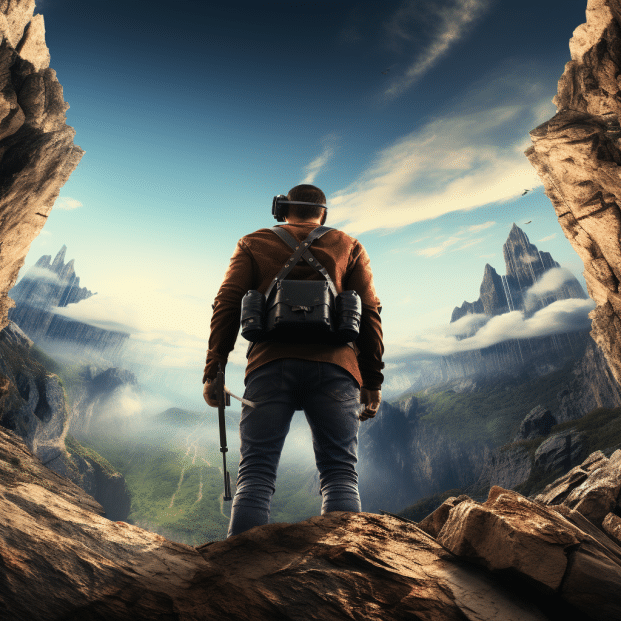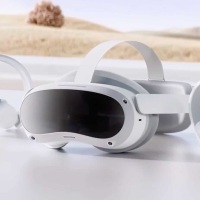Mastering Motion Sickness: Tips for a Smooth VR Experience in Gaming

The realm of video gaming has been irrevocably transformed by the advent of Virtual Reality (VR) technology. Through VR gaming, players are transported to immersive worlds that were once confined to the realms of science fiction, elevating engagement to unprecedented levels. However, amidst this remarkable evolution, a challenge persists: the specter of motion sickness. This unwelcome companion can disrupt the otherwise seamless journey through virtual realms, causing discomfort, dizziness, and nausea. But fret not, for there exist strategies and techniques that can empower you to conquer motion sickness and bask in the wonders of a harmonious VR experience.

The dawn of Virtual Reality (VR) experience has heralded a new age of interactive entertainment, shattering the confines of screens and controllers. Instead, it propels players into mesmerizing digital worlds, where creativity knows no bounds and heart-pounding adventures await. This technological marvel has captured the imaginations of enthusiasts worldwide, allowing them to step beyond reality’s threshold. Yet, amidst this revolution lies a challenge that demands attention: the enigma of motion sickness.
Motion sickness in VR experience, a familiar adversary encountered during car rides or sea voyages, can materialize within the immersive landscapes of virtual reality. In contrast to conventional gaming’s static environments, VR experience gaming draws players in, forging an illusion of genuine presence within its digital tapestry. The technology’s brilliance, while enchanting, can occasionally lead to a sensory dissonance between the visual and vestibular systems. This discord can result in sensations of dizziness, nausea, and unease.
Within this guide, we embark on a voyage to comprehend and conquer the labyrinth of motion sickness in VR experience gaming. We navigate the intricacies of this phenomenon, peering into its underlying mechanisms. Armed with a comprehensive arsenal of strategies, we empower gamers to navigate the virtual realm with grace. By mastering the art of quelling motion sickness, players can fully unlock the potential of VR experience that redefine the limits of possibility.
## Understanding Motion Sickness in VR
Motion sickness in VR occurs due to a mismatch between what your eyes perceive and what your inner ear senses. In the real world, when you move, your inner ear detects the motion, and your brain processes the visual cues accordingly. However, in VR, your eyes might perceive movement that your inner ear doesn’t detect, leading to a sensory conflict that triggers motion sickness.
Deciphering the Complex Dance of Senses in VR
The advent of Virtual Reality (VR) has ushered us into an era of immersive experiences that defy the conventional boundaries between reality and the digital realm. Through the lens of VR, we can traverse distant galaxies, explore ancient ruins, and inhabit fantastical worlds, fundamentally reshaping our interaction with technology and entertainment. However, amid the awe-inspiring allure of VR experiences, a formidable challenge looms—motion sickness.

Motion sickness in the context of VR experience is a familiar hurdle for many. It challenges the very core of our sensory perception, arising from the intricate interplay between our eyes, ears, and brain—a symphony of sensations that can evoke discomfort, disorientation, and even reluctance to partake in the immersive vistas that VR promises. As we embark on this exploration to comprehend motion sickness within the realm of VR, we will peel back the layers to unveil the science underpinning it, delve into its psychological dimensions, and chart a course toward a more seamless and enjoyable journey through virtual reality.
The Intricacies of Virtual Reality: Allure and Complexity
The inception of virtual reality might have been conceived in the realm of science fiction, where visionary writers painted vivid tapestries of virtual landscapes beyond the confines of our immediate reality. Today, these imaginative renderings have manifested as tangible encounters, thanks to the rapid strides in technology. The convergence of VR headsets, motion controllers, and haptic feedback mechanisms has orchestrated an environment that responds to our every gesture, bestowing upon us an immersion unparalleled in the realms of interaction and entertainment.
Yet, within this technological marvel resides an enigma—a potential for our senses to diverge. While our eyes ensnare us in a dynamic and captivating virtual world, the inner mechanisms of our ears, entrusted with maintaining our sense of equilibrium, might detect a discrepancy in movement. This paradoxical dance of senses underpins the emergence of motion sickness, reshaping our understanding of how our bodies engage with the digital and physical realms.
Unraveling the Dance of Senses: Illuminating the Science Behind Motion Sickness
At the heart of motion sickness within the VR experience resides a nuanced choreography involving two primary sensory systems: vision and the vestibular system. Our eyes, adorned with their remarkable prowess to perceive depth, motion, and spatial orientation, act as the gateway to the immersive realms of VR. However, it is the vestibular system, nestled within the inner sanctum of our ears, that roots us in the physical world by gauging our bodily position and movements.
In reality, these two sensory systems harmonize effortlessly, orchestrating a seamless perception of our surroundings. When we amble, drive, or partake in any motion, our eyes and vestibular system collaborate to deliver a consistent experience to our brain. Within VR, this harmony can falter. As we sway our heads or bodies within the virtual expanse, our eyes paint a picture of motion, yet the vestibular system might remain oblivious to the corresponding movement, yielding a sensory dissonance. This discord is the catalyst for motion sickness, as our brain endeavors to reconcile the conflicting signals, giving rise to the discomfort and disorientation associated with the phenomenon.
The Mind’s Role: Psychology and Expectation
Delving into the world of VR experience, we encounter the intricate dance between sensory inputs and the human mind. While the central conflict between the eyes and the vestibular system drives motion sickness, the psychology behind the phenomenon is equally significant. The interplay of psychology in how we perceive discomfort within VR cannot be underestimated. Psychology introduces a vital layer to our encounter with motion sickness.
Our brain’s anticipation of movement, influenced by visual cues and past encounters, can significantly impact the severity of motion sickness. A vivid example lies in the scenario where our eyes signal rapid motion while our physical state remains still. In response, our brain may perceive an anomaly, thereby heightening the chances of experiencing motion sickness.

Psychological elements extend further, with anxiety, stress, and fear exerting their influence. Individuals harboring anxiety may find themselves more susceptible to discomfort due to their heightened sensitivity to sensory discrepancies. The comprehension of these intricate psychological threads is paramount, not only in addressing motion sickness but also in enhancing the broader VR experience.
The Road Ahead: Navigating Motion Sickness in the VR Landscape
The expanding horizons of virtual reality paint a vivid picture of the future, promising revolutionary strides in gaming, education, training, and even therapy. However, as we stride forward, the challenge of motion sickness looms ever larger. This challenge, if surmounted, could unlock the boundless potential of VR.
In the forthcoming sections, we delve into an array of strategies, techniques, and approaches that empower individuals to conquer motion sickness in their VR experiences. From gradual acclimatization and discerning game selection to meticulous setting adjustments and the cultivation of relaxation techniques, our toolkit equips you to traverse the virtual terrain with confidence and ease, for the best VR experience.
Embracing the Future: Mastery of Motion Sickness in the VR Experience
Our journey towards mastering motion sickness within the VR experience is a captivating expedition into the interplay of technology, biology, and psychology. By unearthing the scientific foundations of this phenomenon and acknowledging the profound impact of the human mind, we unlock the gateway to immersive experiences free from the constraints of discomfort.

As this exploration unfolds, we invite you to embark on your own quest. Through knowledge absorption, courageous experimentation, and adaptive learning, you’re poised to step into virtual realms with renewed insight. The allure of VR beckons, offering comfort, joy, and the mastery of your personal sensory expedition.
## Choose VR Games with Care
Not all VR games are created equal when it comes to motion sickness. Some games involve minimal movement and are better suited for individuals prone to motion sickness. These can include puzzle games, architectural explorations, and experiences with static viewpoints. On the other hand, fast-paced games with intense movement and rapid camera rotation might trigger discomfort. Before diving into a game, read reviews, watch gameplay videos, and consider whether the game’s mechanics align with your tolerance for motion.
## Gradual Exposure and Acclimatization
If you’re new to VR gaming or have experienced motion sickness before, it’s essential to ease yourself into the experience. Start with games that involve limited movement and shorter play sessions. As your body and brain acclimate to the virtual environment, you can gradually increase the intensity and duration of your gaming sessions. Over time, this exposure can help desensitize you to the triggers of motion sickness.
## Optimize the Settings for the Smooth VR Experience
Many VR games offer settings that allow you to customize your experience, and these settings can play a crucial role in preventing motion sickness. Consider adjusting the field of view (FOV), reducing or disabling camera shake effects, and turning on comfort features like snap turning or teleportation. Some games also provide options to adjust movement speed and sensitivity, which can help you find a balance that suits your comfort level.
## Prioritize Frame Rate and Performance
Smooth gameplay is not only crucial for immersion but also for reducing the likelihood of motion sickness. Low frame rates and lag can exacerbate discomfort and increase the chances of motion sickness. Ensure that your VR setup meets the minimum hardware requirements for the game you’re playing. Invest in a VR-ready PC or console and prioritize a high-refresh-rate headset to maintain a smooth visual experience.
## Choose Your Play Area Wisely
The physical environment in which you play VR games can also impact your susceptibility to motion sickness. Make sure your play area is well-lit and free of obstacles that could cause you to trip or stumble. Clearing the space around you allows for better spatial awareness, reducing the chances of disorientation and discomfort.
## Take Breaks and Listen to Your Body
Playing VR games for extended periods without breaks can increase the likelihood of motion sickness. Pay attention to your body’s signals and take breaks whenever you start to feel any discomfort. Step out of the virtual world, remove your headset, and give yourself time to recalibrate. Hydration and fresh air can also contribute to reducing motion sickness symptoms.
## Utilize Ginger and Natural Remedies
Ginger has long been known for its anti-nausea properties. Consuming ginger in various forms, such as ginger candies, tea, or supplements, can help alleviate motion sickness symptoms. Some users have reported positive effects from using essential oils like peppermint or inhaling fresh air from an open window during VR sessions.
## Practice Breathing and Relaxation Techniques
Mindfulness and relaxation techniques can help reduce motion sickness symptoms by calming the body and mind. Deep breathing exercises, meditation, and focusing on a fixed point within the virtual environment can help stabilize your senses and mitigate feelings of nausea and dizziness.
## Experiment with Different VR Headsets
Not all VR headsets are created equal in terms of motion sickness. Different headsets have varying levels of comfort, field of view, and refresh rates. If you find that you experience motion sickness frequently with one headset, consider trying a different model to see if it provides a more comfortable experience.

Conclusion: Embarking on a Smooth VR Experience: Conquering Motion Sickness
Embarking on a journey through the immersive landscapes of VR gaming is an exhilarating endeavor. However, it’s essential to acknowledge that, for some, the road to virtual adventure can be marred by the challenge of motion sickness. This unwelcome companion, characterized by discomfort and nausea, can hinder the seamless exploration of virtual worlds. Yet, armed with patience, experimentation, and self-awareness, mastering motion sickness within the realm of VR experience is not only attainable but also transformative.
Understanding the intricacies of motion sickness is the first step toward triumph. By comprehending the factors that trigger this phenomenon, you can proactively navigate around its pitfalls. Choosing your VR games with care plays a pivotal role. Opting for titles with smoother movements, slower pacing, or adjustable comfort settings can significantly mitigate the risk of discomfort. Furthermore, delving into the settings menu of your chosen game allows you to fine-tune elements such as field of view and movement sensitivity. Tailoring these options to your comfort level can foster a more harmonious VR experience.
However, perhaps the most crucial guide lies within your own body. Listening to its signals is imperative. Start with short sessions to allow your senses to acclimate to the new reality gently. Gradually extend the duration as your tolerance builds. If you sense the telltale signs of motion sickness—be it queasiness or dizziness—heed them promptly. Taking breaks, focusing on a stationary point, or even removing the headset temporarily can provide respite.
The immersive realms of VR gaming beckon, and with the right strategies, you can glide through them seamlessly, unburdened by the unwanted aftermath of motion sickness. This journey requires a fusion of knowledge, thoughtful game selection, settings optimization, and attunement to your body’s responses. As you venture into the dazzling spectrum of VR experience, armed with these insights, you can embrace the excitement and innovation without being ensnared by the discomfort of motion sickness.

















